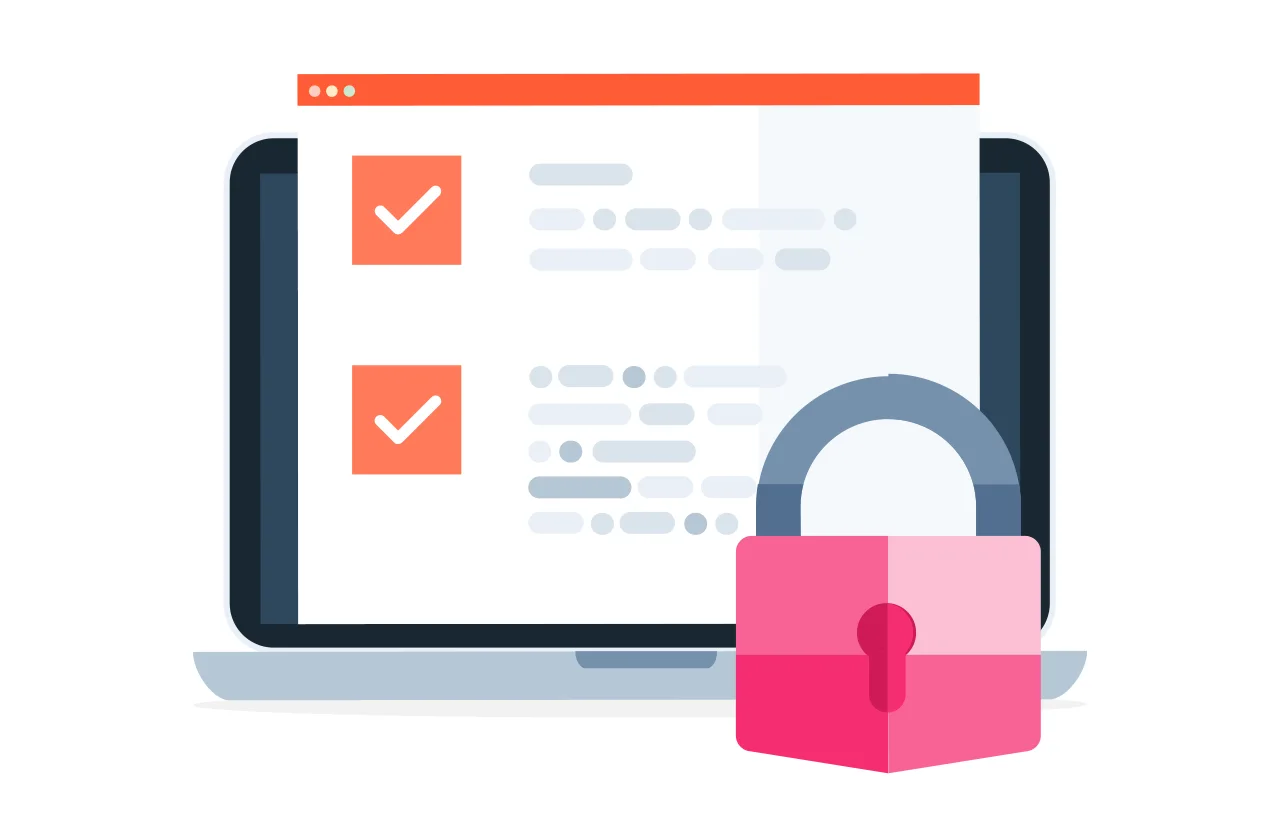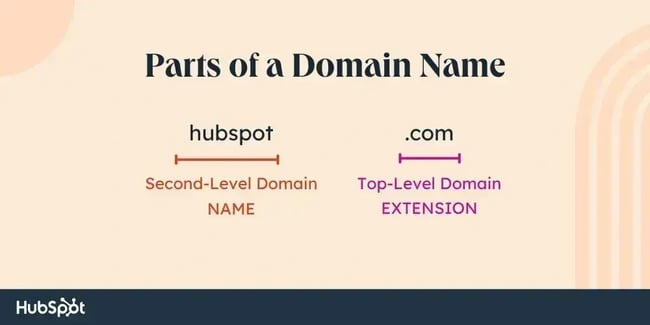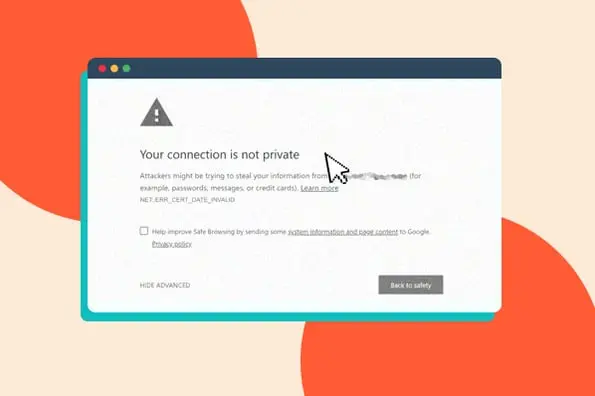Whenever I come up with a new business idea, one of the first things I do is secure its domain name. Yes, it’s that important. As a result, I have about 14 domains – and that list keeps growing.

In this post, I’ll answer your burning questions, such as "What is a domain?”, “How does a domain work?”, and “How do I get a domain?” By the end, you’ll be ready to set up your business website.
Build your website with HubSpot's Free CMS Software
Table of Contents
- What is a domain?
- What does a domain look like?
- What is a domain name?
- Parts of a Domain Name
- What is a domain name example?
- Domain Name vs. URL
- Internet Domain vs. Network Domain
- What are domains used for?
- Types of Domains
- Who manages domain names?
- Setting Up Your Domain
- What is a domain? The starting point for your website visitors’ journey
What is a domain?
A domain is the string of characters that a user types into their browser to find your website. It translates a website’s numerical IP address into a more readable format.
Every website has at least one IP address, a string of numbers that identifies the server where the website’s data is hosted. For example, the IP address for hubspot.com is 172.64.148.142. However, remembering a different IP address for every website you visit would be a pain.

Custom Domain Connection with HubSpot
Inspire consumer trust and brand recognition by connecting your custom domain to your website for free.
- Connect a custom domain to your website for free.
- Keep your brand consistent across channels.
- Allow customers to find you online.
- And more!
A domain name is connected to a website's IP address so people can more easily remember and search for a website by its domain. Their browser can still find the specific web server that hosts the website via the associated IP address.
I think of my website domain like my home address. My friends don’t memorize my house’s GPS coordinates. Instead, when they want to visit me, they just plug my street address into their phones.
The same goes for visiting a website. Instead of memorizing a website’s IP address, visitors simply type in the domain into their browser.
What does a domain look like?
A domain typically consists of two or three words separated by periods. A simple example of a domain is hubspot.com.

What is a domain name?
A “domain name” is the same thing as a “domain,” which is the same thing as an “internet domain” or “web domain.” These terms are used interchangeably.
The maximum length of a domain name, not including its extension (like “.com”), is 63 characters. The minimum length is one character.
For a quick overview of what a domain name is and what it's made of, check out this video by Elegant Themes.
Parts of a Domain Name
A domain typically has two parts: the second-level and the top-level.

Second-Level Domain (SLD)
The second-level domain is the part of your domain that comes before “.com” or another extension. For instance, hubspot.com’s second-level domain is “hubspot.” When buying a domain, make it short and memorable so it’s easy for people to find it.
Top-Level Domain (TLD)
The top-level domain is the extension or the part of your domain that comes after your second-level domain. It indicates the type of entity you are. For example, HubSpot’s top-level domain is “.com” since we’re a commercial entity in the United States.
Most American businesses register their website with “.com.” In fact, according to data from Verisign, the largest TLD in 2023 was .com, with 159.6 million reported domain names in the domain name base.
Other TLDs include “.edu” for accredited post-secondary educational institutions, “.gov” for government, and “.org” which is usually for nonprofits.
What is a domain name example?
An example of a domain name is usps.com. This is made up of a second-level domain (“usps”) and a top-level domain (".com”).
Other examples of popular domain names include:
- youtube.com
- irs.gov
- harvard.edu
- redcross.org
Check out more in the image below:

These are just a few domain name examples — there are literally millions more. According to data from Verisign, there were over 359.8 million registered domain names at the end of 2023.
Domain Name vs. URL
A URL includes your domain, but your domain is just one part of a URL. A URL, also called a web address, typically consists of a protocol, domain name, and path.
For example, the URL of this blog post is https://blog.hubspot.com/service/what-is-a-domain. It's made up of the following parts:
- Protocol (“https://”)
- Domain name (“blog.hubspot.com”), which consists of a subdomain (“blog.”), a second-level domain (“hubspot”), and a top-level domain (“.com”)
- Subdirectory (“/website/”)
- Path (“/what-is-a-domain”)

Internet Domain vs. Network Domain
An internet domain is the type of domain I’m talking about throughout this article. When I want to look up something on HubSpot’s website, I type in “hubspot.com” instead of a bunch of numbers because I know HubSpot’s internet domain.
The Domain Name System (DNS) translates internet domain names to IP addresses so browsers can locate web pages.
A network domain is something entirely different. It describes a group of interconnected devices like desktops, printers, and servers sharing the same purpose.
An administrator is usually in charge of managing the devices within this network. Users in a network domain can communicate with each other but often have different access levels depending on their role.
What are domains used for?
Domains are used to simplify how visitors find your website, but they do so much more than that. Below, I’ll look at several other reasons domains are used.
1. Gaining Ownership
Registering a domain is like reserving internet real estate. No one else can claim it while you have it registered.
2. Solidifying Brand Identity
A domain name establishes a consistent online brand identity. For example, a visitor moving from my website’s homepage to my blog to my knowledge base will notice that the core domain name remains consistent.
This reinforces other consistent elements, like the color scheme and typography.

Custom Domain Connection with HubSpot
Inspire consumer trust and brand recognition by connecting your custom domain to your website for free.
- Connect a custom domain to your website for free.
- Keep your brand consistent across channels.
- Allow customers to find you online.
- And more!
3. Establishing Credibility
A domain name that aligns with your company name makes your website appear more legitimate and professional to users. That builds trust with visitors so they feel comfortable taking action, like submitting a survey or form on a web page with that same domain name.
For example, if you want to create a free business website, you could use WordPress.com and choose the free subdomain mycompanyname.wordpress.com. However, to exude a more professional image, you could buy a custom domain name mycompanyname.com.
Pro tip: You can build a website (no coding skills required) using Content Hub and connect a custom domain for no extra charge.
4. Being Memorable
Make your domain memorable so that it’s easy for visitors to quickly enter it into their search bars — resulting in more direct traffic to your site.
For example, T-Bones Great American Eatery has a short and sweet domain name: t-bones.com. This web domain is much easier to remember than an alternative like t-bonesgreatamericaneatery.com.
5. Standing Out Against Competitors
A simple but catchy domain name distinguishes your site from competing sites with clunkier or confusing domains. For example, if Google had kept its original name of BackRub, it might not have competed as well with Yahoo and other search engines.
6. Building Authority
As a rule of thumb, the older a domain is, the more authority it has, which helps it rank better in the SERPs. That’s because it’s had time to accumulate quality content, internal links, and backlinks. All the more reason to register a domain name sooner rather than later!
Types of Domains
- Generic Top-Level Domains (gTLD)
- Country Code Top-Level Domains (ccTLD)
- Internationalized Country Code Top-Level Domains (IDN ccTLD)
- Subdomain
To better understand possible domain names, let's look at the different types of domains below.
1. Generic Top-Level Domains (gTLD)
gTLD refers to the best-known and most broadly used TLDs:
- .com
- .net
- .biz
- .org
- .info
Today, “.com” is the most popular by far. As of December 2023, 46% of global websites used a .com top-level domain. The next most popular — “.ru” — is used by only 5%.
2. Country Code Top-Level Domains (ccTLD)
These two-letter TLDs refer to specific geographical locations. Here are the most common ones:
- .cn (China)
- .ru (Russia)
- .de (Germany)
- .br (Brazil)
- .au (Australia)
- .uk (United Kingdom)
- .nl (Netherlands)
3. Internationalized Country Code Top-Level Domains (IDN ccTLD)
These are domains that can be displayed in non-Latin character sets (e.g., Chinese).
4. Subdomain
A subdomain is part of a larger domain, appearing before the root domain name (e.g., blog.hubspot.com). Since a subdomain appears to the left of the SLD, it is also referred to as a third-level domain (3LD).
Pro tip: With Content Hub, you can add your custom domain to HubSpot for free. This allows you to connect your new domain to hosting, CDN, and security features all at one time.
Who manages domain names?
Several organizations are involved in managing domain names. At the top of the hierarchy are organizations like the Internet Assigned Numbers Authority (IANA) and Internet Corporation for Assigned Names and Numbers (ICANN).
These bodies manage policies around domain name registrations, accredit domain name registries, and oversee the DNS. They typically do not interact directly with the public.
Domain name registrars are companies people are more familiar with. Examples include GoDaddy, Namecheap, and Domain.com. These registrars allow you to register available domains for a fee.
For years, I used Google Domains because it was relatively cheap ($12 per “.com” domain), included domain privacy for free, and was already a part of the Google suite of tools I use in my business.
But in 2023, it was acquired by Squarespace, and since then, I’ve found the user experience to be pretty disjointed and confusing. And while Squarespace also offers free domain privacy, its domains cost more ($20 per “.com” domain) than what Google Domains had been charging.
Now, I use Namecheap to register my domains. It’s affordable ($11.28 per “.com” domain) and includes domain privacy for no extra charge.
Setting Up Your Domain
To use a custom domain name, you need to buy and register one. From there, you can associate that domain with your server and hosting provider, making your site accessible via the web address.
One easy way to do this is to connect your domain to your website with HubSpot. It’s free. I’ll walk you through how to do it:
Step 1: If you haven’t yet, purchase a domain.
HubSpot isn’t a domain registrar, but it does provide web hosting and a drag-and-drop website builder—so anyone can have a professional website.
You can purchase a custom domain by clicking “Buy a domain” in your free HubSpot account. This part is powered by GoDaddy.


Type in your desired domain. If it’s already taken, GoDaddy conveniently recommends some alternatives.

Having your domain registrar separate from your web host is actually a good thing. Whenever I built blogs, the freelance developer I worked with always recommended not putting all my eggs in one basket. That way, if something goes wrong with one provider, it doesn’t ruin your whole online presence.
Step 2: Update DNS records.
Updating your DNS records is not as scary as it sounds. I’ve done it many times before, and I’m not a developer.
Your DNS records are with your domain registrar. So, wherever you bought your domain (e.g., GoDaddy), log into that account and find the DNS records. HubSpot has easy-to-follow documentation on how to do this.
Step 3: Wait for DNS records to propagate.
After you’ve followed the steps in HubSpot’s documentation, sit back and relax! It could take up to 24 hours for the records to propagate. If there are any errors, the HubSpot dashboard will let you know.

What is a domain? The starting point for your website visitors’ journey
By now, I hope you realize why I’m so quick to register domain names for my business ideas. They’re the online address prospective customers use to visit your website.
So be sure to register and connect your custom domain to your website so you never miss out on new online business opportunities.
Editor's note: This post was originally published in February 2019 and has been updated for comprehensiveness.

Custom Domain Connection with HubSpot
Inspire consumer trust and brand recognition by connecting your custom domain to your website for free.
- Connect a custom domain to your website for free.
- Keep your brand consistent across channels.
- Allow customers to find you online.
- And more!








![13 Best Blog Hosting Sites in 2024 [Analyzed by a Pro Blogger]](https://knowledge.hubspot.com/hubfs/blog-hosting-sites-1-20241104-7164803.webp)
